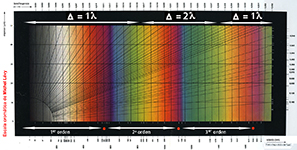
As we have already seen, the interference colour is produced when the retardation between the waves vibrating in perpendicular planes inside the crystal is equal to a whole number of wave-lengths.
This means that a yellow interference colour will appear equally with a retardation of 410 mµ (which is the landa of violet), or 820 mµ (2 * 410), or 1230mµ (3 * 410) and successive multiples.
It is important for us to be able to recognise each of these retardations, as in each case, the birefringence of the crystal (the difference between the highest and lowest refractive index) which produces them will be very different.
In order to distinguish the colours produced by different multiples of wavelengths, the interference colours are grouped in orders, as shown in the figure, which is a reproduction of the Michel-Levy chromatic scale.
Black-grey, yellow, orange and red are grouped together in the first order. These colours represent retardations equivalent to: less than landa of any colour, landa of violet, blue and green respectively.
The second order is made up of the six basic colours: violet, blue, green, yellow, orange and red. The first three correspond to the retardations of one landa of their complementary colour, whilst the other three (yellow, orange and red) represent the retardations of two landa of their complementary colours.
The next orders are also made up of these six colours, but logically they represent retardations of increasingly higher multiples of landas.
The limit between the various orders is fixed in the mixture between violet and red.
If we look at the chromatic scale, we will see that the colours of these first orders are clearer, whilst those of the higher orders are diffuse, and from the fifth order, the colours are blending towards the colour white. This is because for the first order colours, the retardations are small and can only be multiples of one particular wavelength. On the other hand, the high colours represent very high retardations which may be multiples of more than one wavelength and as the complementary colours of these wave lengths are annulled, some mixed interference colours appear.
For example, a retardation of 410mµ is only a multiple of violet (so the colour yellow will appear). If the retardation is 1230mµ, this is equivalent to 3 landa of violet as well as 2 landa of orange, meaning that these two colours will be annulled and the interference colour will be formed by a mixture of yellow and blue.
A series of minerals with increasingly higher interference colors are shown in the figure below.
How can we determine the order of the colour?
Index | Introduction | PPL | XPL ortos | Interf colour | Previous | Next